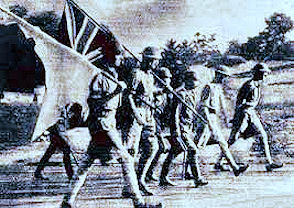2/26th Battalion A.I.F.
Australian Army and the Second AIF
At the outbreak of the Second World War in September 1939, Australia's Army was predominantly a part-time force that was limited by the Defence Act to service in Australian territory. In order to support Britain in the war in Europe the Australian Government announced, on 15 September, the formation of a 'special force' of 20,000 men for service 'at home or abroad as circumstances permit'. Drawing on the traditions of the Australian force that had served in the First World War, the new force soon became known as the Second AIF. It was raised in isolation from the existing military structure and had its own conditions of service, unit establishments and seniority lists. Five Second AIF Divisions were eventually raised - the 6th, 7th, 8th and 9th Infantry Divisions, and the 1st Armoured Division.
The differences between the AIF and the existing home-based militia force caused numerous administrative and strategic difficulties and there was considerable friction between the members of the two forces. The material differences between the two were progressively removed, a process accelerated by the entry of Japan into the war, but ill-feeling persisted in some quarters until the end of the war. In order to preserve the strength of the militia for home defence, in June 1940 its members were prevented from joining the AIF. In February 1942 regulations were changed to allow members of the militia to volunteer for service with the AIF, which meant being able to be sent anywhere in the world, but they would stay with their existing units. If 65 per cent of the establishment strength, or 75 per cent of the actual strength, of a unit volunteered for the AIF, that unit then became an AIF unit.
Formation
The formation of the 2/26th Infantry Battalion began with the appointment of the first Commanding Officer, Lieutenant Colonel Arthur Boyes, on the 1st. November 1940. A shortage of camp accommodation, however, prevented the battalion assembly as a unit until the 26th. November when the first of its personnel marched into Grovely Camp. The 2/26th drew its recruits from Queensland and Northern New South Wales and trained at Grovely until the Battalion relocated to Redbank Camp on the 29th. January 1941. A weekly cross-country training run earned the battalion its nickname, "the gallopers".
On the 24th. February 1941 the 2/26th began moving to Bathurst, NSW and joined the other Battalions of the 27th Brigade - the 2/29th and 2/30th - as part of the 8th Division. The 27th Brigade was the last AIF infantry brigade raised for service during the Second World War. The battalion left Bathurst on the 29th. July 1941 bound for Singapore, via Melbourne, arriving on the 15th. August 1941.
Deployment
On Singapore Island the 2/26th was camped near Changi village on the south-eastern tip of the island. With war against Japan increasingly likely, at the start of October, the Battalion began deploying to Malaya where it continued its training and prepared defences. It was split between the area around Kota Tingii, on the south-eastern tip of the Malayan peninsula, and Jasin in the west-coast sultanate of Malacca. On the night of the 6th. December 1941, the Battalion stood to arms and was concentrated north of Kota Tinggi. It saw no action for the ensuing month and on the 10th. January 1942, moved to Johore, on the western side of the peninsula.
The 27th Brigade formed part of Westforce and fought alongside British and Indian troops. The Australians was deployed around the Segamat sector. The 2/30th was in the foremost position at Gemas, where it was to act as a "shock-absorber" against the initial Japanese attack. The 2/26th was deployed in the Paya Lang Estate, while the 2/29th was deployed at Buloh Kasap but it was later sent to Muar to reinforce the Indian brigade.
Following the 2/30th's successful ambush at Gemas on the 14th. January, the 2/26th conducted a fighting withdrawal to Yong Peng, Ayer Hitam, and a number of other locations, as Westforce withdrew towards Singapore Island.
Between the 26th. and 27th. of January the 2/26th held the Simpang Rengam crossroads at 46-mile post, where they were shelled by Japanese artillery and strafed by Japanese aircraft. By the 28th. January the 2/29th was involved in the heavy fighting at the Namazie Estate rubber plantation. That day and the next the battalion inflicted heavy casualties on the Japanese. The 2/26th proved to be particularly successful in fighting these rearguard actions and its morale was high.
With Indian troops protecting the final withdraw, the brigade entered Johore Bahru on the 30th. January and crossed the Causeway into "fortress" Singapore Island.
Surrender
When the Japanese attacked Singapore on the 8th. February the Brigade defended the Causeway sector. They could not stop the Japanese, however, and on the 15th. February, 1942 the British Commander on Singapore surrendered. The 2/26th spent the next three-and-a-half years as prisoners of war (POW, PsW or PW).
After the surrender the battalion was concentrated in Changi goal, where they were used as labour for work parties, first in Singapore and then in other parts of Japan's Greater East Asia Co-prosperity Sphere. Men were sent to Burma and Thailand to work on the railway, while others were sent to Borneo and Japan.


